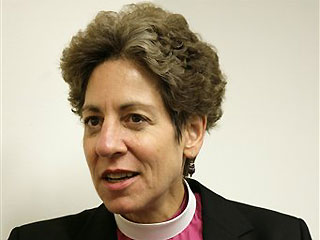Katharine Jefferts Schori. The Heartbeat of God: Finding the Sacred in the Middle of Everything. Skylight Paths, 2011. ISBN: 9781594732928.
The Most Rev. Dr. Katharine Jefferts Schori is the twenty-sixth Presiding Bishop of The Episcopal Church. In that role, she serves as the chief pastor to the Episcopal Church’s 2.4 million members in 16 countries and 110 dioceses. Jefferts Schori entered the priesthood when she was ordained in 1994 following a career as an oceanographer. She started her career in the ministry by working part-time in parish ministry as a priest while also serving as a university lecturer and hospice chaplain. Jefferts Schori then served as Bishop in the Diocese of Nevada before being chosen for her current role. Her earned doctoral degree is a Ph.D. in oceanography from Oregon State University. Jefferts Schori also holds multiple earned graduate degrees including a M.Div. from Church Divinity School of the Pacific. Her most recent books are The Heartbeat of God: Finding the Sacred in the Middle of Everything (2011), Gospel in the Global Village: Seeking God’s Dream of Shalom (2009), and A Wing and a Prayer: A Message of Faith and Hope (2007).
Book Basics
 The Heartbeat of God: Finding the Sacred in the Middle of Everything challenges readers to reconsider their own life of faith in response to a single challenging question: “Will our hearts respond with strengthened beat, in tune with God’s own heartbeat, sending more life out into the world?” (p.xvi)
The Heartbeat of God: Finding the Sacred in the Middle of Everything challenges readers to reconsider their own life of faith in response to a single challenging question: “Will our hearts respond with strengthened beat, in tune with God’s own heartbeat, sending more life out into the world?” (p.xvi)
The book is divided into five parts (“Connecting with the Margins,” “Connecting Faith with Public Life,” “Connecting with Creation,” “Connecting with the Heart of God,” and “Healing Broken Connections) each of which contains four to ten brief chapters focused around a single practical idea. To ensure readers continue to struggle with the content, each chapter concludes with a question or questions for reflection that invite personal introspection and application of the material.
While Katharine Jefferts Schori speaks primarily of The Episcopal Church, as one would expect given her current position, she also includes numerous remarks that indicate similar work to what she describes in her illustrations is being undertaken by those affiliated with numerous other denominations. Further, she speaks about new possibilities that are emerging as the larger Christian community continues to evolve, “Our job as a church is to stay and engage the questions, to keep pushing the boundaries and to always remain open to the new things that God has in store for us” (p.185).
Relevant, practical, and actionable this book is well suited for personal study. When accompanied by the free downloadable 83 page Leaders’s Guide by Jenifer Gamber, it becomes an incredibly rich resource for small groups. Those seeking to engage the material alone or in community should do so at their own risk, realizing that it has the power to change the way you live by resetting your spiritual cardiac rhythm to that of God’s own heart.
So What?
Christianity is not a religion of rules, but relationships. It is not intended to become part of our life, but to bring new life and to transform how we engage the other. Following Jesus is not about living on a mountaintop experiencing one spiritual high after another, but about loving God by loving neighbors in the context of the every day, or, in the words of Katharine Jefferts Schori, “in the middle of everything.”
These discussion questions are found at the end of three chapters, each from a different part of the book. Take a few minutes to begin formulating your answers.
- What part of the dream of God challenges you? What keeps you from engaging it? (p.66)
- How can we increase our capacity to hear, and to turn back toward the kingdom of God? How can we live with love for all people? (p.133)
- Where is God’s image becoming flesh within our church? What can we imagine about God’s possibility? How is the great dream becoming flesh and blood reality? (p.195)
